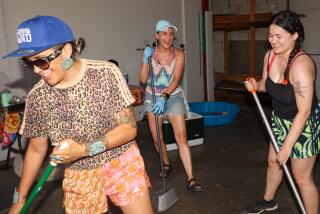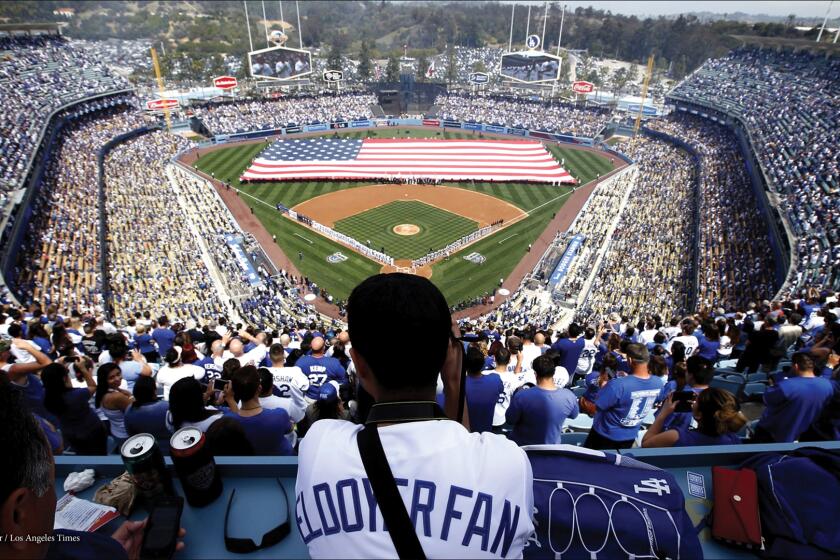Diversions : The Biggest Little Museum : Memorial Day, the Malki Will Honor and Celebrate American Indian Heritage
- Share via
A picture of Army Specialist 4th Class Arthur P. Roberson stands out just inside the front door--the only door--of the Malki Museum, a one-room building in the wide-open spaces of Morongo Indian Reservation in Riverside County.
A special delivery wire, dated June 19, 1971, is pinned next to the young soldier’s likeness, explaining that he was killed in the line of duty in Vietnam.
For the record:
12:00 a.m. May 20, 1991 For the Record
Los Angeles Times Monday May 20, 1991 Home Edition View Part E Page 6 Column 1 View Desk 1 inches; 29 words Type of Material: Correction
Malki Museum--An incorrect date appeared in the headline on Memorial Weekend events at the Malki Museum in some editions of Sunday’s View section. The museum will honor American Indian veterans on Sunday.
Because of the recent military victory in the Persian Gulf War, there is added incentive to celebrate Memorial Weekend. But to make sure that soldiers like Roberson--an American Indian--are not forgotten, the Malki Museum is holding an event next Sunday to honor veterans--American Indian veterans in particular.
But don’t expect a maudlin affair. The Cahuilla tribe plans to take its little corner of the desert by storm. The commemoration will be part of the annual “Indian Fiesta,” a Morongo tradition since the museum opened in 1964. The show of Indian culture will bring athletic Aztec dancers from Mexico City performing in colorful headdresses; artisans--including Navajo from Arizona--displaying and selling jewelry, baskets and rugs, and Pueblo Indians from New Mexico and bird singers from the Morongo Reservation.
Why a fiesta?
“Because if we called it a kewet (a Cahuilla word), people wouldn’t know what it means,” says museum president Katherine Siva Saubel. “The festival is a wonderful opportunity for people to make contact with real Indian people who live on the reservation,” says Paul Apodaca, curator of Folk Art at Santa Ana’s Bowers Museum and emcee of the fiesta for the third year.
People will see “that the indigenous culture of California is intact and growing,” he says. “They will be able to see American Indians, listen to Indian music, watch Indian dance and eat Indian food.”
This is a good thing because many people have misconceptions about what a reservation is like, says Apodaca, who is Mexican and Navajo. Throughout this country’s short history, people have been trying to do away with the Indian culture and the reservations, says Apodaca, who is also a professor at Chapman College in Orange.
“It’s not a concentration camp, not a stockade. It’s a home,” he says, explaining that many of the reservation’s homeowners have jobs in Los Angeles or San Bernardino, for instance, and visit their reservation homes on weekends.
The Morongo Reservation, in the Pass area between the San Jacinto and San Gorgonio mountains, is now home to fewer than 400 Cahuilla, according to Saubel, although more Indians are returning each year.
(Estimates of Cahuilla in the surrounding desert area, mountains and the Pass numbered nearly 20,000 around the mid-1800s, but large numbers were wiped out by a smallpox epidemic, which some say was contracted from soldiers.)
“The things you see around you,” Saubel says as she shows off the fish-bone hooks, baskets, tools and other exhibits at the museum--which will be open during the fiesta--”are remnants of our people, our culture--what’s left. It’s what our people had when they were here.”
Saubel, 71, whose husband, Mariano, was a World War II veteran, is sort of a caretaker of the Cahuilla culture. She has lived on reservations in Palm Springs and the Banning area all her life, and is active in Indian affairs--so much so that she is a three-term appointee to the governor’s Heritage Commission.
She especially wants to draw recognition for the American Indian soldiers, whom, she says, “you would never know were there.”
“They were drafted (starting with World War II), but you never hear about them. My own husband was in the service, they drafted him. We were married just 1 1/2 years when he left. He was gone three years.”
But the most painful memories of her husband’s military service appear to come from after the war, when the couple applied for a GI loan to build a house.
“We lived on the reservation, so we were not entitled,” she says bitterly. “They probably wanted him to leave the reservation, but he said no, he was born here, he will die here.”
Saubel says her husband was eventually granted the right to a loan.
“Before my husband died, they said ‘You can borrow now.’ He was 70 years old. He said no, I don’t want it now. That’s why I live the way I do.”
Saubel lives in a small, weathered trailer on the reservation. For nearly 10 years she has spent much of her income teaching ethnobotany--how ancient Cahuilla used plants for medicine, food and shelter--and from consulting jobs on renovating a house she bought for the price of its move to the reservation. She hopes to teach ethnobotany, Indian cooking and language classes there some day. Her voice rises a pitch or two as she talks about two young boys who want to learn to speak Cahuilla.
“Language is very important,” she says. “If you lose your language, you lose everything. You can’t interpret your songs, your stories. You can’t do anything if you can’t understand the language.”
“To have your own homeland, to foster your own culture, that’s a good idea,” Apodaca says. “That’s the natural order of things, finding security in their culture and revitalizing parts of their culture.”
The fiesta is one key to keeping information about the culture circulating. The original purpose was--and still is--to muster support for the museum, a gold mine of Cahuilla culture, while sharing it through a day of exhibits and entertainment.
The museum already has the support of such academics as Pam Monroe Ph.D, of UCLA; UC Riverside’s Harry Laughton; Margaret Langdon Ph.D, professor in the linguistics department at San Diego University at La Jolla, Thomas Blackburn Ph.D., Cal Poly Pomona, and Lowell Bean Ph.D., ethnologist in the anthropology department at Cal State Hayward. All are on the Malki Museum Press’s editorial board.
This publishing arm of the museum not only corraled some badly needed cash to keep the museum running, it has also helped the museum evolve into a leading resource for researchers and academics all over the world, says Apodaca, who is also an adviser to the Smithsonian Institution’s new Museum of the American Indian.
“It’s the biggest little museum in the world,” Apodaca says. “Even the L.A. Natural History Museum doesn’t publish the same kind of books. . . . A majority of the researchers and academics researching California culture . . . 90% of their libraries are from the Malki.”
Saubel, whose own books include one about plant usage, and the official Cahuilla dictionary, says that publishing “has helped the museum a lot,” but there was another motive to publish. “(We) decided there were a lot of books about Indian people that were biased and a lot were incorrect.”
The books published by Malki Press are dissected by the board to ensure that they are factual and reflect the beliefs of American Indians.
“People generalize about Indians,” Saubel laments. “We all believe in preserving Mother Earth, but our own ways are different. A lot of tribes eat bear meat, Cahuilla do not. We relate to the bear and to the coyote and wild cat.”
Emphasizing the importance of the Earth, Saubel says: “It’s really a shame now, giving up and destroying the land, polluting the water, the air . . . but I guess that’s civilization. I’d rather save everything,” she adds quickly with a laugh, “and not be too civilized.”
The fiesta is a chance, Saubel says, for the rest of society to see the American Indian point of view, while celebrating a holiday all Americans have in common.
“It will be a reminder to people,” Saubel says, and an opportunity “to commemorate the men and women of the Armed Service--it’s something for them.”
A flag-raising ceremony for veterans will begin around noon.
“To me it’s very emotional,” Saubel says. “Some people burn the flag and--that insults me. A lot of our people died for that flag.”
To get to Malki Museum’s Memorial Weekend fiesta next Sunday at the Morongo Indian Reservation, take Fields Road exit from Interstate 10, go north. Take Morongo Road to Malki Museum. Pit barbecue dinner $5.50. Hours: 10 a.m.-dusk. (714) 849-7289.
More to Read
Sign up for Essential California
The most important California stories and recommendations in your inbox every morning.
You may occasionally receive promotional content from the Los Angeles Times.













